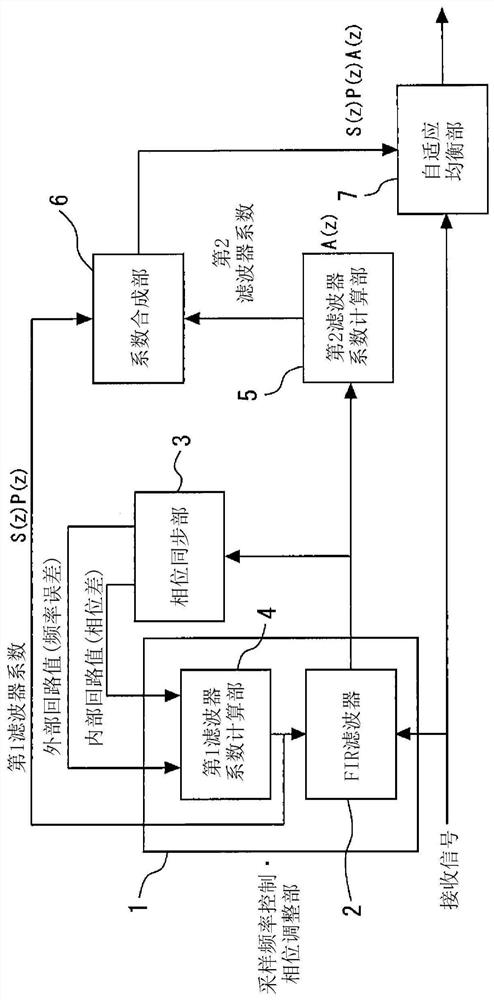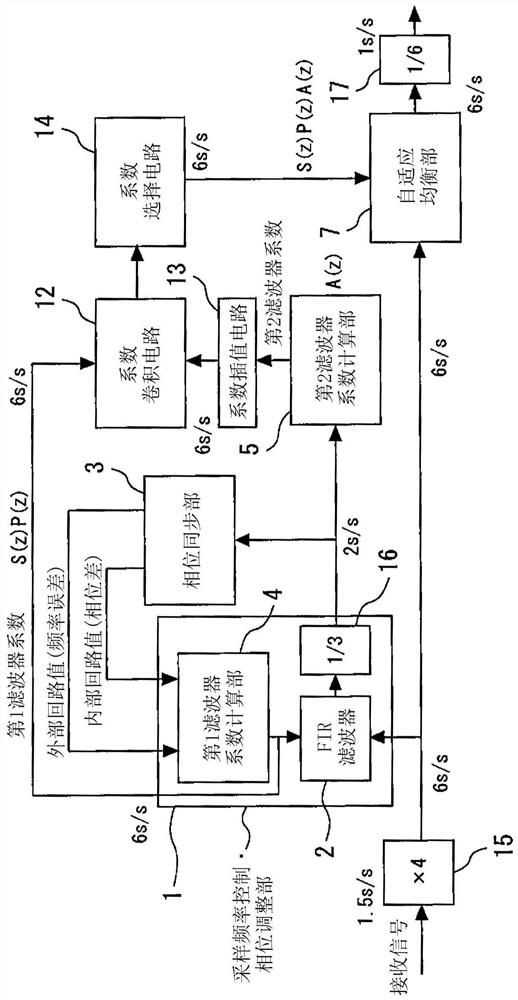Adaptive equalization device, adaptive equalization method, and communication device
A technology of self-adaptive equalization and communication device, which is applied in gearbox control/balance, optical fiber transmission, transmission system, etc., and can solve the problem of increased power consumption of digital signal processing circuits
- Summary
- Abstract
- Description
- Claims
- Application Information
AI Technical Summary
Problems solved by technology
Method used
Image
Examples
Embodiment approach 1
[0026] figure 1 It is a diagram showing the adaptive equalization device according to Embodiment 1. The adaptive equalization device is provided on the receiving side of the communication device. The received signal is a data sequence (sampled signal) sampled at a predetermined sampling rate. The sampling rate of the received signal is 1.5 samples / symbol (1.5 s / s), that is, 1.5 samples per 1 symbol. Data for 1 sample is usually represented by a number of bits (for example, 7 bits or 8 bits). A symbol is a unit that forms information bits in a received signal.
[0027] The sampling frequency control / phase adjustment section 1 simultaneously performs phase adjustment for compensating the phase difference between the received signal and the sampling signal (the phase difference between the phase of the symbol of the received signal and the sampling timing) through the same FIR filter 2 Processing, and processing of sampling frequency control (including sampling rate conversio...
Embodiment approach 2
[0055] Figure 4 It is a diagram showing an adaptive equalization device according to Embodiment 2. The basic configuration is the same as that of Embodiment 1, but the processing method of the FIR filter 2 of the sampling frequency control / phase adjustment unit 1 and the FIR filter of the adaptive equalization unit 7 are different. A 1 / 2 circuit 18 is provided instead of the 1 / 6 circuit 17 .
[0056] In Embodiment 1, the received signal of 1.5 s / s is interpolated once by the ×4 circuit 15 and filtered by the FIR filter 2 of the sampling frequency control / phase adjustment unit 1, and then passed by the 1 / 3 circuit 16 And get 2s / s signal. However, in this embodiment, the processing of ×4 / 3 is simultaneously performed on the 1.5 s / s received signal in the FIR filter 2 of the sampling frequency control / phase adjustment unit 1 and the FIR filter of the adaptive equalization unit 7 . Specifically, in the convolution processing in the FIR filter, only data calculated by the proce...
Embodiment approach 3
[0059] Figure 5It is a diagram showing an adaptive equalization device according to Embodiment 3. The basic structure is the same as that of Embodiment 1, but the form of sampling rate conversion is different. A received signal with a sampling rate of 4 / 3s / s is supplied. The sampling rate of the received signal is converted from 4 / 3 s / s to 4 s / s via the ×3 times circuit 19 .
[0060] In the sampling frequency control / phase adjustment unit 1, the reception signal converted to 4 s / s is subjected to sampling frequency control and phase adjustment processing by the FIR filter 2. The processed signal is converted to a sampling rate of 2s / s via the 1 / 2 circuit 20 . The phase synchronization unit 3 calculates an outer loop value corresponding to the frequency error and an inner loop value corresponding to the phase difference from the output signal, and feeds them back to the sampling frequency control / phase adjustment unit 1 . The first filter coefficient calculation unit 4 of ...
PUM
 Login to View More
Login to View More Abstract
Description
Claims
Application Information
 Login to View More
Login to View More - R&D
- Intellectual Property
- Life Sciences
- Materials
- Tech Scout
- Unparalleled Data Quality
- Higher Quality Content
- 60% Fewer Hallucinations
Browse by: Latest US Patents, China's latest patents, Technical Efficacy Thesaurus, Application Domain, Technology Topic, Popular Technical Reports.
© 2025 PatSnap. All rights reserved.Legal|Privacy policy|Modern Slavery Act Transparency Statement|Sitemap|About US| Contact US: help@patsnap.com



